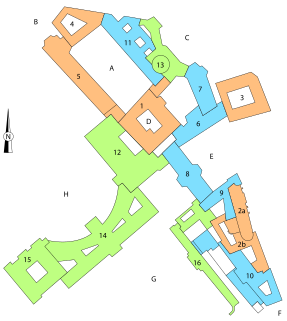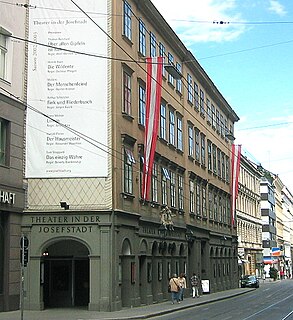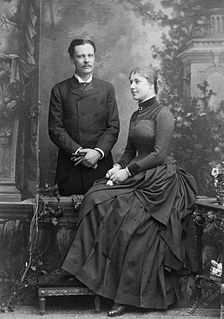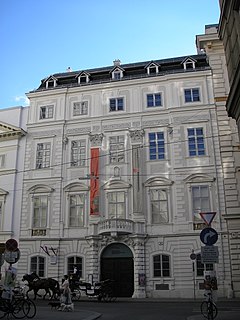
The Academy of Fine Arts Vienna is a public art school of higher education in Vienna, Austria.

The Natural History Museum Vienna is a large natural history museum located in Vienna, Austria. It is one of the most important natural history museums worldwide.

The Hofburg is the official residence and workplace of the President of Austria and was formerly the principal imperial palace of the Habsburg dynasty. Located in the center of Vienna, it was built in the 13th century and expanded several times afterwards. It also served as the imperial winter residence, as Schönbrunn Palace was the summer residence.

The Austrian National Library is the largest library in Austria, with more than 12 million items in its various collections. The library is located in the Neue Burg Wing of the Hofburg in center of Vienna. Since 2005, some of the collections have been relocated within the Baroque structure of the Palais Mollard-Clary. Founded by the Habsburgs, the library was originally called the Imperial Court Library ; the change to the current name occurred in 1920, following the end of the Habsburg Monarchy and the proclamation of the Austrian Republic. The library complex includes four museums, as well as multiple special collections and archives.

The Theater in der Josefstadt is a theater in Vienna in the eighth district of Josefstadt. It was founded in 1788 and is the oldest still performing theater in Vienna. It is often referred to colloquially as simply Die Josefstadt.
The Herrengasse is a street in Vienna, located in the first district Innere Stadt.

The Hofkriegsrat established in 1556 was the central military administrative authority of the Habsburg Monarchy until 1848 and the predecessor of the Austro-Hungarian Ministry of War. The agency was directly subordinated to the Habsburg emperors with its seat in Vienna.

The Imperial Natural History Museum or Imperial Royal Natural History Court Museum of Austria-Hungary was created by (Kaiser) Emperor Franz Joseph I during an extensive reorganization of the museum collections, from 1851–1876, and opened to the public on August 10, 1889. Located in Vienna, the Museum was named in German as "K.k. Naturhistorisches Hofmuseum".

The Esperanto Museum and Collection of Planned Languages, commonly known as the Esperanto Museum, is a museum for Esperanto and other constructed languages in Vienna, Austria. It was founded in 1927 by Hofrat Hugo Steiner and was incorporated into the Austrian National Library as an independent collection in 1928. Today, it is a museum, library, documentation center, and archive. It accommodates the largest collection of constructed languages in the world and a linguistic research library for language planning. Its catalogue is available online.

The Weltmuseum Wien in Vienna is the largest anthropological museum in Austria, established in 1876. It currently resides in the Hofburg Imperial Palace and houses more than 400,000 ethnographical and archaeological objects from Asia, Africa, Oceania, and America. Since November 2014 the museum was closed due to renovation and was reopened on the 25th of October 2017.

Count Manfred von Clary-Aldringen was an Austro-Hungarian nobleman and statesman. He served as the 16th Minister-President of Cisleithania.

The Wienbibliothek im Rathaus, formerly known as the Wiener Stadt- und Landesbibliothek, is a library and archive containing important documents related to the history of Vienna, Austria. Founded in 1856, the library, which also contains a large collection of local memorabilia, is located in the Rathaus in the Innere Stadt first district of the city, and is the official library of the city and state of Vienna.

Schloss Frohsdorf is a castle-like complex in Lanzenkirchen in Niederösterreich and was built 1547–50 out of the ruins of the so-called "Krotenhof".

Countess Marie Karoline von Fuchs-Mollard, known as Charlotte, was the governess of Maria Theresa of Austria.

The Ephesos Museum in Vienna displays antiquities from the city of Ephesus, in modern-day Turkey. Begun in the late 19th century, the collection includes original works of sculpture and architecture, and belongs to the Kunsthistorisches Museum.

A map collection or map library is a storage facility for maps, usually in a library, archive, or museum, or at a map publisher or public-benefit corporation, and the maps and other cartographic items stored within that facility.

The Globe Museum is a museum in the Palais Mollard, Vienna, Austria, part of the Austrian National Library. It was opened in 1956, and is the only public museum in the world devoted to globes, being three-dimensional models of Earth or other celestial bodies, or spherical representations of the celestial sphere.

House of Clary und Aldringen, also known as Clary-Aldringen, is one of the most prominent Austro-Hungarian princely families. Originally from Friuli, Northern Italy, one branch of the family moved to the County of Tyrol around 1500 and to the Kingdom of Bohemia around 1600, where it became one of the leading families of the Bohemian nobility. It produced several notable Austro-Hungarian statesmen, military officers and diplomats.
The k.u.k. War College, also k.u.k. Staff College was the highest military facility to educate, instruct, train, and develop general staff officers of the Austrian Empire and later the Austro-Hungarian Empire.

The Lower Austria Museum, formerly the Lower Austria State Museum, is the national museum for the state of Lower Austria and covers the fields of history, art and nature. It is located in St. Pölten in Lower Austria.

















